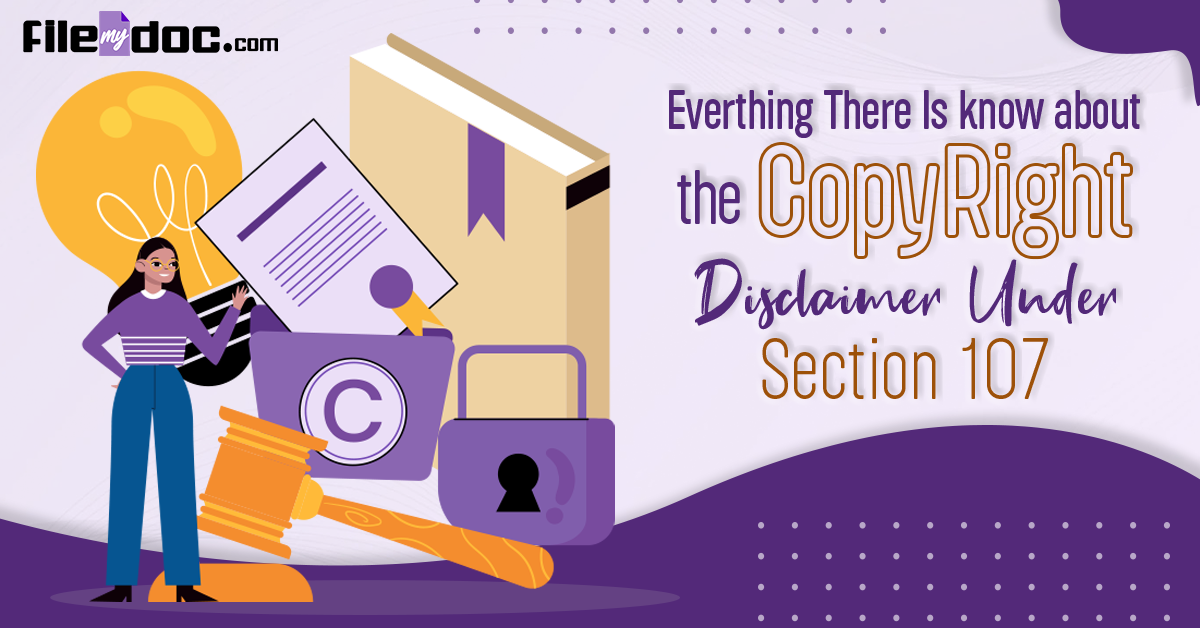
What is Copyright Disclaimer Under Section 107?
Copyright Disclaimer Under Section 107 states that under specific conditions, unauthorised use of material that is copyrighted is permitted when this use falls in the category of being ‘fair’. Under the Copyright Disclaimer under Section 107 of the Copyright Act 1976, there is an allowance for ‘fair use’ of copyrighted material for such purposes as education and research, scholarship, criticism, news reporting, comment, and teaching. Fair use refers to the use allowed by the copyright statute, which would otherwise be looked at as an infringement.
Personal use, use for education, where in both conditions it is not for profit, allows for the use of the fair use allowance. If there is doubt regarding whether specific use will be considered fair, the best thing to do is go in for an attorney consultation.
In Copyright Disclaimer under Section 107, there is a complete list of the purposes that allow the reproduction of a particular content since it is fair. These are research, scholarship, teaching, news reporting, comment, and criticism. Within section 107, four factors should be considered while determining if a specific use will be looked at as fair. These factors are:
- The character and purpose of use, including if it is to be used for commercial purposes or nonprofit educational purposes
- The copyrighted work’s nature
- The substantiality and amount of the used portion relative to the entire copyrighted work.
- The user’s effect on the potential market for, or on the value of, the copyrighted work.
What is Copyright?
The ownership of copyright provides the owner of a work exclusive right to use that work, barring a few exceptions. For an original work created by a person, with the work fixed in a tangible medium, the person becomes the automatic owner of the work’s copyright.
Copyright is an official means of safeguarding the creative work of an artist. Usually, it is possible to secure various kinds of content via copyright. Examples of such works are songs, artwork, films, poems, books, and plays. The recent past has seen increased copyright protection for sites and other content online. Several categories of works are covered under copyright protection, some being:
- Audiovisual content, like online videos, movies, and television shows
- Musical compositions and sound recordings
- Written works, like musical compositions, books, blogs, articles, and lectures
- Visual works, like advertisements, posters, and paintings
- Computer software and video games
- Dramatic works, like musicals and plays.
As a norm, creators are given exclusive rights to their creations, like their paintings, films, books, etc. If this creation is reproduced by someone else, the person will have infringed the copyright. In the case of an author, copyright will protect the specific manner in which the author has expressed self in work. Copyright does not cover systems, ideas, or factual information and has been provided in the piece of work.
To use a person’s work, the best thing to do is obtain permission from the person who owns the copyright. After you get the permission, it is safe to use the copyrighted material without worrying about infringement. If it is not practical to get permission, one must avoid using material that is copyrighted.
Features of Copyright Disclaimer
Some prominent features of a copyright disclaimer are:
- A major part of the content covered by copyright disclaimer, like the data that can be downloaded, comes under copyright protection. The concerned agency manages the content brought under the copyright disclaimer
- In the case of reports which can be accessed and displayed images under license, the copyright belongs to others
- The content held under copyright cannot be further distributed or reused/ reproduced by others without the person’s prior permission. It can be accessed or reproduced only if permissible under copyright legislation
- The agency holding the copyright of certain content may permit its partners or subscribers to distribute the information.
Process of Copyright Disclaimer
- See if you require a copyright
The first step towards protecting a work by bringing it under the copyright disclaimer statement is to place a notice to this effect on all visually obvious copies. E.g., books, photographs, sheet music, and films
- Place an appropriate symbol
The copyright symbol © has to be incorporated. A ‘copyright’ or ‘corp’ too can be used to make it clear that the work is covered by the copyright
- Mention the year of publication
Under copyright law, the distributed copies or phone records of work are referred to as published materials. The year of the publication needs to be mentioned when registering your content for copyright. The year of issuance of work by sale or through leasing should be clearly mentioned
- Declare the name of the copyright holder
The name of the copyright holder must be mentioned
- Attach copyright notice
The copyright notice should be attached or placed in a segment of your work. If you wish to secure the copyright in your company’s name, make sure that your business is legally registered and functions according to the rules and regulations
- The copyright statement must be placed in your work
The copyright notice should be attached or placed in a segment of your work. It should be clearly visible and not hidden from view
- Rights statement must be included
The rights statement should be attached to show what rights a copyright owner is holding. In case you do not wish that anybody uses your idea. You should have an All Rights Reserved statement. Some rights reserved statements should be put if you wish to share some parts of the content with others. If you desire to leave all hold over the content, you can mention no rights owned.









